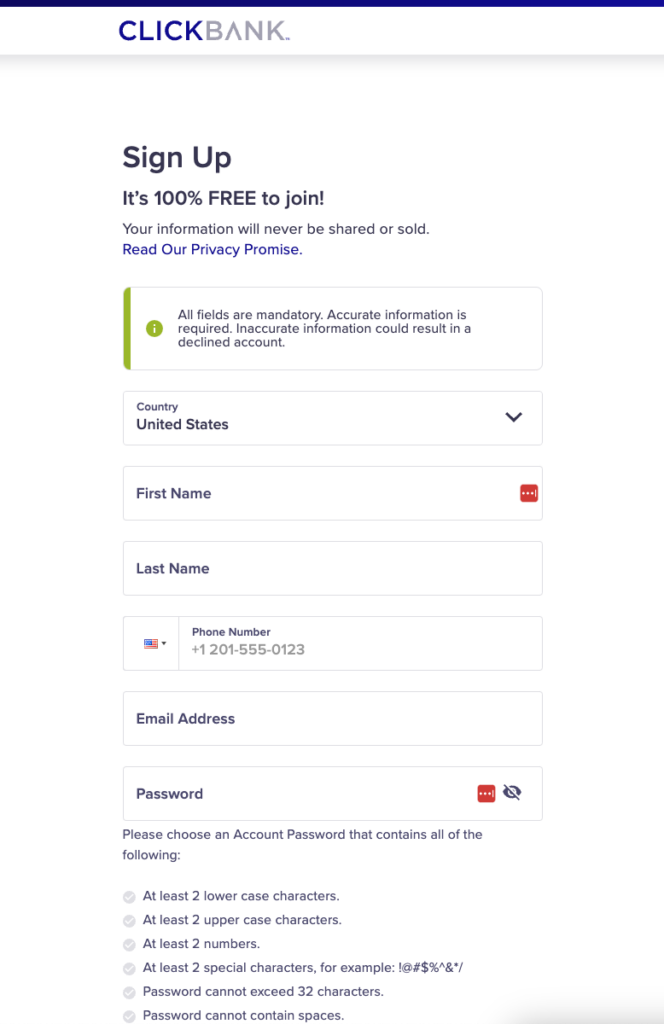ClickBank Affiliate 101: Guide to Making Money in 2025

We’ll show you the exact process of setting up your ClickBank Affiliate Account, choosing your niche and products to promote, and three different strategies for generating traffic and making your very first sale.
Use the table of content below to jump to the topic that interests you most.
Table of Contents
Creating Your ClickBank Affiliate Account
Before we get into the technical approach of how to make your first ClickBank commission, you need to set up your account correctly.
Visit the ClickBank signup page, and fill it out with your name, email address, country, and phone number.

After that, scroll down and click the continue button to read through the terms and conditions.

Once you’re sure that you understand the terms, scroll down and click the “Accept Terms and Conditions” button.
Then, click the “Join ClickBank!” button, and you’re officially a member. Download the suppression list and accept, and you will be redirected to your account homepage.

From here, you can complete your profile. Add your personal and tax information, and ClickBank’s instant account verification check will review your identity and location details for approval.
If you don’t have a corporate tax ID, your personal identification number will also work. (Note that ClickBank only requires this information for US-based accounts.)
Then, set your goal to “promote products as an affiliate,” choose your company’s revenue, and save.
You’ve now finished your profile and can start promoting offers.
ClickBank will send 1099 tax forms every January to US accounts with more than $600 in earned commissions to file their taxes. But there’s no other information needed now.
If you need additional help setting up your account, ClickBank’s step-by-step lesson is a great resource.
Creating Your ClickBank Affiliate Sub-Account
The overall ClickBank account is where you manage sub-accounts of all types, including vendor accounts where you can sell your own products through ClickBank affiliates.
So the next step is to set up your affiliate sub-account. Navigate to the accounts menu, and click the “Accounts” button. Set the account type to an affiliate, and create a nickname for this sub-account.

Choose a Niche and Product(s) to Begin Promoting as a ClickBank Affiliate on Your Niche Site
Now that you’re all signed up, it’s time to find the perfect niche for your new ClickBank business.
If you’re not quite sure what a niche is and why you need one, let’s cover that first.
What Is a Niche? Why Do You Need One?
A niche is a specific subcategory of a larger industry, like the Keto Diet or weight loss for new moms, not general weight loss.
Focusing on a single niche is crucial if you want to make the most of your marketing efforts.
- Without a niche, you’ll struggle to develop a brand, convince visitors to come back to your site, or sign up. After all, who wants to sign up for a newsletter that covers a broad range of topics at random? Would you sign up for a weekly email about anything and everything?
- Without a niche, you’ll struggle to become an authority in your space. Follow the Google E-A-T (Expertise, Authoritativeness, Trustworthiness) principles to get Google rankings.
- It’s much easier to start ranking for niche keywords in Google and get featured on smaller niche publications and blogs.
The 4 Factors of a Good ClickBank Niche
When you’re choosing a new niche, you want to make sure that you line up these four factors for the best results:
- Your Interests and Expertise: It’s easier to write about what you know and build relationships with potential customers when you share their passion.
- High-Quality, Sellable ClickBank Products: You need something to sell.
- Consumer Demand: There can be no business without interested customers.
- Manageable Competition: You don’t want to be just another affiliate among hundreds of established websites and blogs.
You may wonder why it’s crucial that you have expertise or are interested in a topic.
It’s simple. You need the ability to create a high volume of engaging content for your niche site and social media. And the chances are much higher if you care about your niche.
Start With a List Of Your Interests and Areas of Expertise
The best way to get started is to simply list your areas of interest and expertise in an Excel spreadsheet. List them in order of interest or experience.
Even include hobbies you might discard as there not being any money in. Knitting, meditation, and gardening are all large niches with many full-time affiliate marketers, bloggers, and influencers in them.
Once you have the list, add extra fields to reflect the consumer demand, competition, and available ClickBank products.
You can use this simple spreadsheet to evaluate the earnings potential of your different interests, hobbies, and fields of expertise.
Find ClickBank Products
If your goal is to make passive income from ClickBank products, you need to choose a niche that has high-quality, sellable ClickBank products in it.
Luckily, with ClickBank’s extensive product catalog, this isn’t a problem for any of the big niches.
Start with your dearest interest or area of expertise. Head to the ClickBank marketplace and search for the most relevant search term. In this case, “woodworking” in itself is the main keyword of the niche.

As you can see here, we get a decent amount of relevant results even for this seemingly obscure topic.
There are two main numbers you want to pay attention to here, the gravity score and the average value per conversion.
The gravity score is the average number of different affiliates that have made at least a single sale in a month.
If you want, you can sort by gravity, but when searching by keywords, this may show some irrelevant results.
Scroll through the relevant products and highlight a few with high gravity scores and average sale conversions.
You shouldn’t automatically settle on a product just because the numbers look right on the surface.
You need to go deep and evaluate each product.
- Evaluate the landing page: will it effectively convert the traffic you send its way?
- Check the customer reputation: will it negatively affect your new site’s brand if you promote it?
First, check the landing page of the product. Some ClickBank product landing pages are more than 10 years old and will convert at a horrible rate.
Next, check the public perception of the product. Make sure that it’s a high-quality offering, so you avoid damaging your brand by recommending the product.
Evaluate Consumer Demand
Once we know there are reliable products that are already selling and paying out significant commissions to affiliate marketers, you need to evaluate the general consumer demand.
While gravity score can be a signal, it doesn’t always mean it’s a large marketplace. For example, 60 affiliates can average 90 total sales per month, and the gravity score will still be 60.
And a single affiliate can sell hundreds of products per month without contributing more than one point to the gravity score.
So it’s essential to check other sources.
The first thing you want to do is evaluate the general search demand. You can use the Google Ads Keyword Planner to check the search demand for free, or use a tool like KeySearch Starter.
But we recommend you invest in a professional keyword research and SEO (search engine optimization) tool like Ahrefs or SEMrush.
Because it’s what we use, we’ll use Ahrefs here, but any tool will do. They’re similar enough that you can follow our instructions regardless.
Start with the keywords explorer tool (keyword researcher in SEMrush.) Search for the broadest keyword for your interest.
In this case, that would be “woodworking.”

With 32,000 search volume for the general keyword of woodworking globally, it may not seem like a large niche. But that’s promising. The only problem is that the keyword’s difficulty is 84/100 (more on this in our next section).
If you explore the keywords further, you’ll see hundreds of keywords with thousands of searches per month, including ones with almost no competition. Click the “Keyword ideas” section, and you should see quite a few words. Next, you want to figure out if it’s something that people spend money on. You can see that “woodworking tools” gets almost as many monthly searches per month as the general keyword.

Shopping ads are displaying popular tools, which is a good indicator that people are willing to spend money on this hobby.

It can also be a good idea to see how passionate people are about the niche by looking for subreddits, Facebook groups, forums, and other online communities.
These are all great signs that there’s more than enough consumer interest in the niche and product.
In this case, you can indicate the consumer demand is high for the niche.
Evaluate the Competition
Finally, you want to evaluate the competition. It’s very time-consuming if you don’t invest in a professional SEO tool. With one, like Ahrefs or SEMRush, you can see the competitive organic metrics for every keyword you search for.
The main keyword for woodworking is incredibly competitive and out of our reach. Keywords with scores of 50 and above typically require 100+ unique backlinks from relevant sites before you can even break into the top 10 results. But the good news is that we don’t want to target generic top-of-the-funnel keywords anyway. We want to explore the keywords more closely related to the ClickBank products we found. Check out the volume and competition for keywords related to your ClickBank products, and identify keywords that have low-medium competition and low volume. If you can identify 10+ keyword opportunities like this with relative ease, you can conclude that the competition is low-medium for that specific sub-niche.
Rinse and Repeat for Every Interest
It might take you a while to complete the steps above, but that doesn’t mean you should just settle on the first niche you explore. Repeat the steps for all of your top interests and areas of expertise, and create a list of keywords that you could potentially use.
Once you’ve got a complete list, you can choose based on consumer demand, competition, products, the value per sale, and how interested you are in the topic. Being able to compare your options on paper will help you make the right decision.
Create Your Niche Site the Right Way
After choosing a niche, the next step is to create your niche site right. With a solid foundation, you can start attracting organic traffic. But if you choose the wrong host and domain name, you’ll stab yourself in the foot. A poor choice will diminish the effectiveness of all your marketing efforts.
Choose a Reliable, Fast Hosting Provider
Page loading speed is an important Google ranking factor. It has a direct impact on whether people can find your new site or not. Plus, page speed also affects the user experience, whether people will stay on your page, and if they convert. 70% of consumers say page speed influences their purchasing decisions.
And just a few extra seconds of loading time can mean they end up bouncing (leaving without interacting with your page).
Wix and Siteground are some of the worst-performing hosts on desktops. WP Engine is the best host for WordPress sites, while Weebly is the fastest website builder. Before you choose a host, make sure that you do your research and pick a reliable option.
Choose a Memorable, 100% Available Domain Name
Your domain name is one of the first things a potential visitor and customer will experience.
Don’t set up a generic domain name to try multiple niches at once. People are looking for authoritative content, someone who knows what they’re talking about.
Something like “all-products-reviewed.com” is a horrible domain name. It’ll impact your CTR in search and make it harder for you to build a brand and newsletter.
Also, avoid domain names where primary top-level domains (TLDs) like .com and .net are already taken. (You can use a domain registrar like Namecheap to check with a search.)
Just because you can register a domain name like woodworkingforbeginners.ai doesn’t mean you should.
Instead, you can use a relevant term from the niche, like shop, and combine it with your name, for example, johnnieswoodshop.com.
As long as the domain name indicates the niche and is easy to remember, you’re good to go. It doesn’t need to be a creative masterpiece.
But don’t start a business where someone else owns the .com domain, or it’s not clear what your site is about (unless you go with your personal name.)
Invest in a Relevant Template or Theme
In Envato Market (formerly known as ThemeForest), you can easily find professional themes that suit most niches. You can either keep them the way they are or let the stock photos inspire you to take pictures in a similar style.
A bit of authenticity goes a long way. So if you can find the courage to star in your photos and videos, that won’t just keep costs down, but it may also make it easier to resonate with your target audience.
A fast-loading, good-looking site on a memorable domain name is the perfect jumping-off point for an affiliate marketing career.
Create Content Targeting Relevant Keywords
Once your niche site or blog is up and running, the worst thing you can do is to start writing about random topics. Don’t try to create content based on what’s floating around in your head at any given moment. That’s a waste of time. Instead, you want to strategically target keywords relevant to as many of your potential (affiliate) customers as possible.
Identify Low-Hanging Fruit: Keywords with Low Competition and Decent Volume
An easy way to find low-hanging fruit is to start with a broader niche keyword, like going back to woodworking in the keyword explorer. Select “view all” under Keyword Ideas that have matching terms.

Then, sort keyword ideas by search volume. It’ll show you a list of all keyword ideas with the search term “woodworking” in them, in order from most searched for to least searched for.

Then you can set up a global volume filter to a minimum of 500. You can also set out a maximum of 20,000 to filter out popular branded searches.
Then you can set up a global volume filter to a minimum of 500. You can also set out a maximum of 20,000 to filter out popular branded searches. Next, set up a keyword difficulty filter of max 35 to filter out keywords that are too hard to target in the short term. (In Ahrefs, KD stands for keyword difficulty, and after the search volume, it’s the most crucial metric.) Now, all you need to do is evaluate the keywords for relevance and then add the relevant ones to your keyword list.

You can click the plus sign to add it to a keyword list within Ahrefs or copy and paste it to a separate spreadsheet. Go through the pages (and adjust your filters) until you find at least 20–30 (ideally 50+) low-hanging fruit keywords with a volume of 500+ globally. If you’re struggling to find new ideas on the “terms matching” page, you can also try the “also rank for” and “questions” topics to find more ideas. Once you have that starting list of keywords, it’s time to move on to other sources.
Steal Keywords from Competitors
Another effective way to find content topics to write about is to figure out what keywords drive profitable traffic to your competitors. Of course, since you’re just starting, you might not know who your competitors are. One easy way to look up smaller niche competitors to model is to search for “top [NICHE] blogs” in Google. That will usually deliver some “roundup posts” highlighting multiple smaller competitors in that niche. For example, when searching for “top woodworking blogs,” the two top results are lists of 70 and 10 sites.
You can also find competitors by looking at what domains rank for the keywords you want to target. Note domains (other than Pinterest or social platforms) that are potential competitors.
Answer the Most Commonly Asked Questions
The people also ask box in Google results is a vital source of keyword ideas and SEO pointers. All you need to do is Google any keyword and scroll down to find it. For generic terms, you may need to add a “what is” to the search. When searching for “how to make a coffee table,” Google suggests these related questions.

Add any questions that seem like they have potential to a list, and check their search volume and competition.
Note: Even if the volume is too low for these keywords to target with an entire blog post, you can also target these questions by adding them as small H2 or H3 subheading sections in a blog post targeting a relevant keyword.
For example, you could answer, “What is the best wood to build a coffee table?” in your how-to-build a coffee table guide.
You can read our guide on niche keyword research if you want more help to find even more keyword ideas.
Use Keywords in Title, Subheaders, and Other On-Page SEO Basics
You might be wondering, now that you have your list of keywords, what do you do with them?
The short answer is, you write an SEO-optimized blog post or article targeting each one.
If you’re new to SEO, follow these SEO basics:
- Always use the exact match (100% identical) keyword in your meta title and description.
- Always use your keyword in the first paragraph of your introduction.
- Use the keyword in an H1 tag (automatically happens for WordPress and other CMS.)
- Include the main keyword or related keywords in image alt tags and titles.
- Use related keywords and questions in H2 and H3 subheadings.
- Cover related topics in detail and vary your use of semantically related keywords.
You can’t have a solid digital marketing campaign if you ignore social media. As a ClickBank affiliate, YouTube and Pinterest are two of the best platforms to target.
Create YouTube Videos Accompanying Your How-To Guides
When it comes to how-to material, YouTube is the second-largest search engine in the world after Google itself. 86% of consumers say they regularly turn to YouTube to learn something new. Plus, for these how-to topics, YouTube videos are often the top results highlighted in video snippets by Google. So, to maximize your organic traffic, you can create video guides for YouTube to go along with your written content.
Some rules of thumb for YouTube:
- Speak faster and with more energy than you would in a casual conversation. You need a strong enough presence to engage complete strangers.
- The first 10 seconds are the most important. Showcase the finished product, start with a joke, or do something else to grab people’s attention and incentivize them to continue watching.
- Plan your content and edit the final video down to avoid rambling and side notes that add little value.
- The thumbnail is almost as important as your video itself. It must be eye-catching and convince people to click and start watching your video.
Watch and analyze videos that are ranking at the top for relevant search terms to explore what it takes for Google to give you a push. Learn and emulate, but don’t copy.
Create Pinterest-Shareable Visuals for Your Guides and Comparison Posts
There are over 600 million visual searches on Pinterest each month. Many of these searches are for projects related to ClickBank’s digital products.
To make matters even better, Pinterest users spend 50% more than users from other social channels.
That makes it one of the most potentially profitable channels online, full stop.
Before you devote a lot of time to the platform, you should check if your targeted niche has an active community.
With woodworking, we’ve already seen Pinterest pages in the search results for several of our keywords.
If we do a quick search for the keyword on Pinterest, we can see tons of trending posts and even a few accounts.

In our case, we could take steps to create a shareable photo or graphic to promote specific woodworking plans from our affiliate products.
- A high-resolution professional photo of a finished DIY product you made with skills learned from a ClickBank product.
- A before-after picture of a completed room renovation (involving multiple plans and DIY items).
You won’t get anywhere if you try to share the official banners or images of the ClickBank affiliate product itself. You need to get more creative and use some elbow grease if you want to become successful.
Nurture Visitors with An Email Campaign
Most visitors leave your site without ever clicking an affiliate link, much less buying anything. To make the most of the valuable targeted traffic you get, set up an email course or newsletter. Email marketing, on average, has an ROI of $42 for every dollar you spend. That’s why it’s a channel you can’t afford to ignore. In this section, you’ll learn exactly how to get started.
Choose an Affordable Email Marketing Platform
There’s no need to break the bank on the email marketing platform when first starting.
It’s easy to export and move leads to another platform, or just upgrade your plan if you need more advanced features later. Mailchimp is 100% free to use (up to 1,000 monthly email sends) and is a great starting point. You can even create custom landing pages with the free plan.

Once you’ve signed up, it’s time to start attracting subscribers.
Offer a Relevant, Compelling Lead Magnet
Develop a lead magnet that offers actual value to your site visitors (from your combination of SEO and social media marketing.) Our theoretical competitor in the woodworking/DIY space, Jen Woodhouse, offers free building plans to get visitors to sign up for her newsletter.

That lines up perfectly with what most of her visitors expect. Remember, most of them come from how-to, DIY, and building plans-related keywords. This alignment is crucial because a lead magnet only works if it’s relevant to your visitors. If you target a range of keywords with different overarching themes, you can also develop more than one lead magnet and use them for different pages.
Set Up an Automated Drip Campaign that Nurtures Subscribers into Customers
Okay, so you’ve set up a lead magnet, and some visitors are starting to sign up. Now what? How do you turn them into customers? The best way to do that is with something called a “drip campaign.” It’s basically an automated email campaign with multiple emails, designed to turn subscribers into customers.
Start with a welcome email, offer at least two emails of more tips and value, and then try to recommend the ClickBank affiliate product in email #4. With a Mailchimp plan, you can set up automated emails based on when the subscriber signs up. A drip campaign or opt-in funnel is the secret weapon of every seasoned affiliate marketer.
Track Results and Optimize How You Spend Your Time and Money
The biggest mistake of beginners is to try things blindly. They don’t use any form of tracking and guess what works and what doesn’t.
Install and Use Google Analytics
If you want to become a super affiliate, you should get very familiar with tracking and analytics tools like Google Analytics. It gives you a breakdown of traffic and affiliate link clicks from each channel. (If your vendor installs your code through ClickBank, you can also track sales and other eCommerce data.)
If you want access to this kind of data, start by creating your Google Analytics account, creating a new property, and copying that code.
Once signed up, you can find the ID in the admin area. Copy the UA code under the property or click the “tracking code” section and get it from there. If you run your website with WordPress or another platform like Squarespace, all you need is the id. With WordPress, search for and install a Google Analytics plugin first.
Use ClickBank Tracking IDs to Track the Source of Sales
If you want to track the link clicks and sales to ClickBank from different sources, you can use ClickBank tracking IDs in your links. Use a channel name like Facebook, or a specific campaign.
Once you promote the different links and start getting traffic, you can break your sales and “hops” (page views) down by source. Go to ClickBank reporting, and click “By Tracking ID” to sort your stats by tracking ID.
That way, you can know not just which platforms are bringing the most traffic, but which ones are driving the most affiliate commissions. Once you’re driving heaps of sales, you can probably contact vendors and ask them to install your tracking tags directly for access to more data.
Next Steps
Once you’ve found your niche, created your site, identified low-hanging fruit keywords, and started posting content, it’s easy to go into tunnel-vision. But if you stop trying to improve your knowledge or skill set after reading just this article, you’re unlikely to succeed in the long run.
Instead, you should find a thriving community of niche marketers, just like you, and learn from their successes and failures along the way. You can join our Facebook mastermind group to find the support system you need to succeed, for free!
Frequently Asked Questions (FAQs)
What is ClickBank?
ClickBank is an online platform that serves as a marketplace for digital products, particularly in the realm of affiliate marketing. It facilitates the connection between product creators (vendors) and affiliate marketers who promote and sell those products.
Is ClickBank Legit?
Yes, ClickBank is a legitimate and well-established online platform. It has been in operation for many years and has gained a reputation as a trusted marketplace for digital products and affiliate marketing.
Is ClickBank Free?
Yes, signing up for a ClickBank account is free. Both vendors (product creators) and affiliates can create accounts on ClickBank without any upfront cost.
How do I create a ClickBank Affiliate Account?
To create a ClickBank Affiliate Account, visit the ClickBank signup page, fill out the required details, including your name, email, country, and phone number. Accept the terms and conditions, complete your profile by adding personal and tax information, and set your goal to “promote products as an affiliate.”







